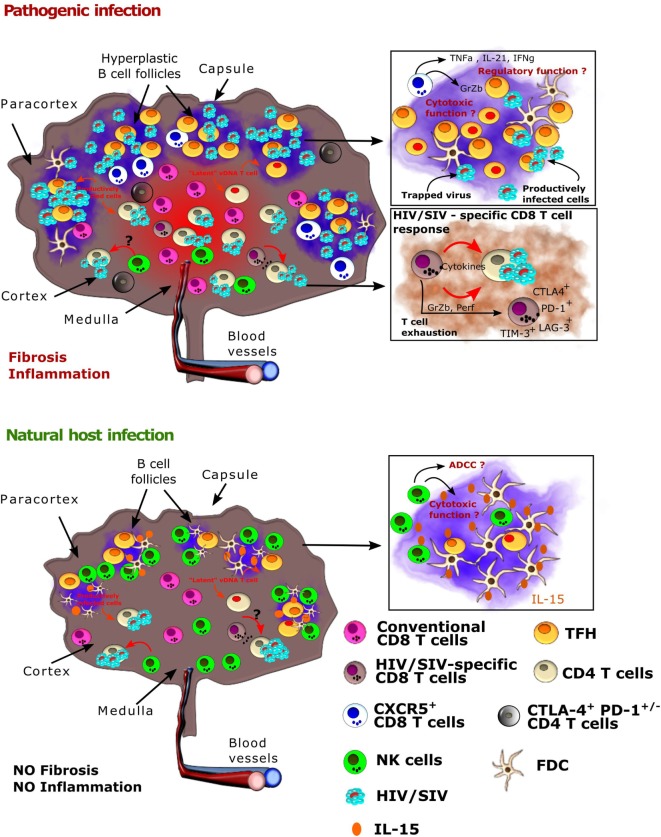Figure 1.
Viral and host immune cell dynamics in lymph nodes (LNs) from natural hosts versus HIV-1/SIVmac infections. Schematic representation of a LN after HIV or SIV infection in pathogenic models (human, macaques, top) and natural hosts [African green monkey (AGM), sooty mangabey, bottom]. (Top) HIV-1 and SIVmac infection in, respectively, humans and macaques result in the formation of hyperplastic germinal centers in LNs with massive B cell proliferation. TFH cells also expand during HIV-1 and SIVmac infections. Inflammation is uncontrolled and leads to collagen deposition and fibrosis. The follicular dendritic cell (FDC) network is disrupted on the long term. HIV-1 and SIVmac replicates in combined antiretroviral therapy (cART)-naïve individuals and animals in both T and B cell zones, but the viral burden is highest in the B cell zones (follicles). In the follicles, virus replication is concentrated within follicular helper T cells (TFH). Virus is also trapped by FDC and remains infectious. On cART, virus persists mostly in TFH cells in the follicles, where it is often outreach of conventional CD8+ T cells and of optimal drug concentrations, as well as in CTLA4+CD4+ T cells within the T zone. The latter cells have a capacity for long survival. NK cells and conventional HIV/SIV-specific CD8+T cells are often expressing immune checkpoint inhibitors. The presence of CXRC5+CD8+T lymphocytes has been described, but their role needs to be further studied. (Bottom) In natural hosts, virus replication is strongly controlled during the chronic phase of infection. Most follicles are exempt of virus. Conventional SIV-specific CD8+ T cell responses are weak. NK cells play a major role in the control of viral replication in AGM LNs. Both the IFN-α and NK cell responses appear earlier than in SIVmac-infected macaques. NK cells accumulate in follicles in SIVagm-infected AGMs, which might be a direct consequence of a high production of IL-15 in the follicles. NK cell migration into B cell follicles in response to SIVagm infection is associated with the acquisition of CXCR5. CXCR5+ NK cells express high levels of Fcγ receptors and of CD107a, which raises the question if they have the capacity to control SIVagm replication through antibody-dependent and/or -independent cellular cytotoxicity.

